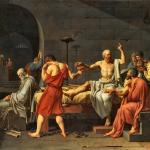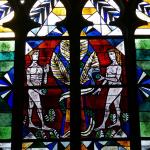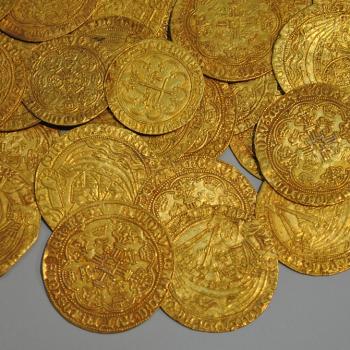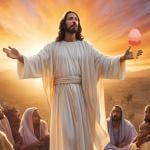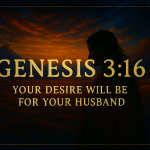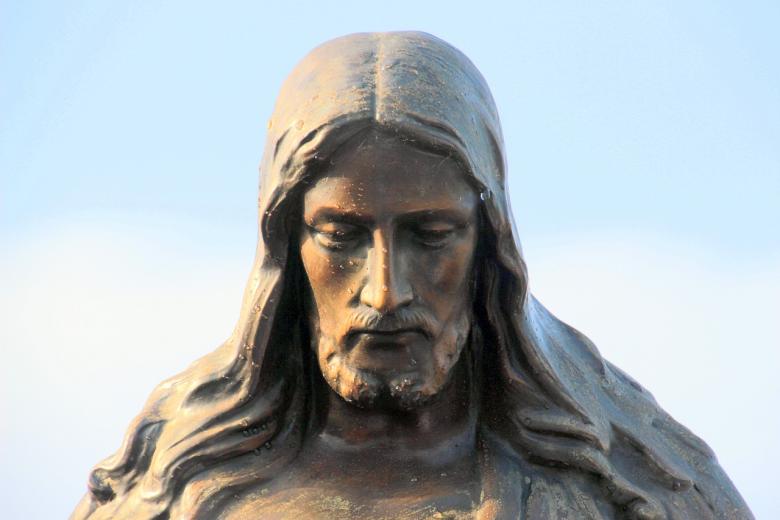
Image by Myriams-Fotos / Pixabay
Well, we did it. We looked at three different ways Jesus’ message was retold for a specific audience. First, we looked at Jesus as a rural preacher. Next, we asked if Jesus was just another Greek Hero. Finally, we saw how Socrates influenced the retelling of Jesus in the gospel of John. This research was part of my graduate work at Northwind Theological Seminary and was compiled into a single paper. Here is that paper.
Introduction
Mark’s account of Jesus begins with the proclamation that is this good news. The gospel accounts are written to tell others about what Jesus said and did while he was on earth. However, those who have read the different gospel accounts will notice that there are many differences between each one. While some try to make them all fit, others try to discredit them because of the differences. Rather than taking either of those positions, I offer that the differences in the gospel accounts are features rather than bugs. These differences are due to the fact that each writer has a specific audience in mind, and this audience is shaped by their own time and place.
Jesus’ life and message shifts throughout the accounts. Earlier writings of Jesus focus on his sayings while time allows for authors to think more critically and make more connections to the Jewish scriptures. We see the shifting of Jesus from a good teacher into one who is God. In the same light, the audience shapes what message is being given and how it is relayed. The need to make Jesus’ message accessible and relatable is both a literary necessity as well as practical. Why should anyone listen to a teacher who was murdered by the Roman Empire? What makes him an authority?
By reading and comparing Q, Mark, and John, we can see how the gospel message has changed throughout time, place, and audience. Each gospel focuses on what would have been important to their recipients and has their place in the Christian tradition. While the different gospel accounts may not harmonize perfectly with each other, we see the thread is the hearer. These gospel accounts are crafted for the rural population, for those who see Odysseus as the hero, and for the lovers of wisdom. Early Christians decided that the differences that each gospel contains – due to the differences in audience over time – were important to understand the whole picture of Jesus’ time on earth. It is imperative that modern Christianity not shy away from this. Rather, we should embrace the differences we see and use this as permission to craft a Jesus that will speak to our current time and place.
Jesus As A Rural Preacher
The majority of scholars today agree that the gospel of Mark was the first gospel written. However, when examining Matthew and Luke, there are a number of similar, sometimes identical, passages that do not align with Mark. The data would suggest a second gospel that was in circulation around the same time.
This second document was labeled as source, “Quelle” in German and shortened to Q, is a hypothetical grouping of sayings of Jesus that would have been available to the writers of Matthew and Luke. These writers would have taken the Gospel of Mark and Q and combined them to their own audiences. There are several reasons as to why this Two Document and Marcan Priority should be accepted considering our current records. John S. Kloppenborg makes a compelling argument for this by noting what is shared by the three Gospel writers and what is different between the three. For example, Mark and Matthew agree without Luke, and Mark and Luke agree without Matthew, however Matthew and Luke do not agree against Mark. Kloppenborg says that a good hypothesis cannot prove everything, but rather should be able to provide a good approximation of most of the data most of the time. While Q is a strong hypothesis for the Synoptic Gospels, it should be put in context with the whole to see if we need to find a missing source for the Gospel accounts.
The Q Source does not have a flushed out theology of Jesus. Rather than focusing on Christology or prophetic implications, Q is most interested in how one ought to live their life in the light of the kingdom of God. What makes the voice of Q stand out is that it includes many rural images, including men in the field and women at the grindstone, those who farm and those who spin. In addition to the rural daily activities, there is a great deal of economic justice. The measure one judges will be used against them as well (Q 6:37-38) and the Lord’s Prayer is a literal debt-canceling prayer. “The Q prayer proposes a quid pro quo: God will cancel their debts if the Q folk cancel each other’s debts.”
The Q gospel has many differences, but the sayings point towards the importance of orthopraxy over orthodoxy. The real-life changes that a rural peasant may experience by adhering to the teachings of Jesus would far outweigh a future home in heaven. While the Synoptic Gospels don’t shy away from the immediate need for action, the theologized life of Jesus contains more than a simple call to action. The Last Supper is a call to remembrance where the Q Gospel is a deed to be done. We see this gospel in the book of James as well and the focus of the life of Jesus without the necessity of death and resurrection. This gospel allows us to open the idea of what a gospel is. The Q Source and its rural first century followers allows us – or maybe forces us – to reconsider what it means to be Christian.
Jesus as the Jewish Homer
The Gospel of Mark is much different from Q – Jesus is ‘Son of God’ and performs miracles throughout the entire account. Generally understood to be written around the destruction of the temple in 70 CE, Mark’s gospel has some questions surrounding its origins. Questions regarding if this Mark is John Mark who was the sister’s son of Barnabas or a second Mark is debated, even if on the margins. However, there is a large amount of evidence that this gospel is coming from the apostle Peter. As the authors note, ”But as to his [Mark’s] Gospel, the tradition regarding Peter’s hand in it is so ancient, so uniform, and so remarkably confirmed by internal evidence, that we must regard it as an established fact.”
While most Bible scholars see Mark as an independent work – without outside sources from other Christians, Dennis MacDonald sees the Homeric Epics as a source of framework for Mark, with the author borrowing major themes and events from the story to retell the hero’s journey. MacDonald has developed a criteria to judge the similarities and differences between these two documents: accessibility, analogy, density, order, distinctiveness, and interpretability. How these criteria are met determines how strong or weak of a case he has for the link between these two stories. MacDonald notes that some stories in Mark have a stronger link to Homer than others, but it is the overall weight of similarities (and differences) that shows the link between Homer and Mark.
MacDonald uses the story of Jesus calming the seas to show the imitation of the Homeric epic. In a side-by-side reading, the stories are very similar. In both, the hero and his companions are at sea when they are met with a violent storm. However, the Gospel of Mark shows Jesus to be more than Odysseus. While Odysseus was helpless and blamed his crew, Jesus calmed the waters and, perhaps in a fatherly tone of voice, invited them to have faith.
In this example, MacDonald looks beyond Odysseus for the Greek model used for Jesus. As the disciples, dumbfounded over what they had just seen, ask who it is who can calm the seas and take power over the wind, MacDonald points to the god of the winds, Aeolus. “When the storm arose in the epic, Odysseus was helpless… Jesus, on the other hand, rebuked the winds and calmed the seas…” MacDonald also finds justification in other details around the story of Jesus, including the protagonist waking mid-storm and the twelve ships of Odysseus with the “other boats that were with him” (Mark 4:36).
What is interesting and compelling about this theory is that it wouldn’t be a reach historically. The Aeneid can be seen as a Roman retelling of Homer’s epic and the concept of the Hero’s Journey by Joseph Campbell has been seen throughout literature from ancient to modern. In a world with competing ideas of the Hero, having Jesus be the hero-God would be easily understood by the audience for which it was originally written.
Jesus as Christian Plato
John’s gospel paints a clear picture of the paradoxical nature of Jesus. John’s high Christology showcases Jesus as both fully human and fully divine. Not only does his actions show this duality, his language is more definitive. “…Jesus uses a number of key ‘I AM’ statements that are unique to the Fourth Gospel and become the hallmark of his teaching. Jesus uses these to identify himself with the name of God… These statements, for which the Gospel of John is famous, allow Jesus to give himself a title that both is consonant with the current context of the dialogue and allows him to point symbolically to his divinity and oneness with God.”
Brown and Moloney argue that this high Christology is evidence for the later writing of John. The fact that John’s vision of Jesus focuses on his divinity and equality with God shows that the Church had time to think more deeply about the impact of Jesus’ work on earth. The Church was also able to reframe the life of Jesus after the failure of the First Jewish Revolt in 65-70 CE. We see each gospel writer reflect on the Roman violence and how Jesus fulfilled their Scriptures. What started out as oral traditions and stories of their Rabbi took real shape as the future of Christianity was under threat from the Roman Empire.
John’s Jesus is not the miracle worker of the Synoptic Gospels, but rather a great orator. “In these exchanges, Jesus is often the instigator and can even be very provocative. He pushes those he encounters out of their comfort zones and challenges them to be open to God working in their midst through him.” John records Jesus as a rhetorician rather than a preacher or parables. Socrates, one of the greatest ancient Greek philosophers, through the writings of Plato, was known for the way he spoke with his opponents and the Sophists. We see Jesus using the Socratic Dialogues in a similar way, and getting similar responses.
In the first book of The Republic, Socrates is in dialogue with several Sophists about the meaning of justice. During the dialogue, he is met with multiple answers. Socrates continues the conversation, trying to pull out a deeper response that gets to the heart of justice. Cephalus’ answer is questioned, but no response is recorded. Polemarchus works through his answer and discovers an inconsistency. Thrasymachus pushes back against Socrates, but eventually does not give a sufficient alternative.
In a similar way, Jesus is often asking questions to those who are asking about him and his teachings. In the Synoptic Gospels, Jesus may prefer a parable or miracle, but John’s Jesus is thoroughly Hellenized. And, similarly to Socrates, Jesus is met with multiple responses. Nicodemus comes to Jesus to ask him for the truth – who is he really? In John 3:1-21, Jesus answers Nicodemus with another question. Only when Nicodemus is clearly puzzled (not understanding the double entendre of being born a second time) does Jesus explain himself. Still, the answer is not as simple as it could be – Jesus employs high rhetoric to reply.
While Nicodemus could represent the Polemarchus character from The Republic, the Jews – as characterized by John as a whole – are clearly the professional intellectuals who cannot understand Jesus. They constantly try to trap Jesus in word puzzles and seemingly unsolvable riddles. When Jesus responds with his own questions, often with the claim of divinity, they become angry and try to stone him (John 8:58-59; 10:30-31).
If Jesus is the analog to Socrates, John takes the role of Plato. Not only does he record the sayings of Jesus, he then goes on to write his own message. John pens three letters that further the meanings of the life of Jesus as well as continuing the Platonic concepts first recorded in his gospel. (Brown and Maloney take note that John, son of Zebudee, “the beloved disciple”, was part of a community that helped shape the letters. Authorship is disputed, but the authoritative name John was important. See Brown, Maloney, p. 12, ch. 5 and ch. 16.)
Jesus as God
MacDonald’s view of the Gospel of Mark being a retelling of the Homeric epics may go a step further – it may include the positioning of Jesus as the One in the beginning that was over the ‘wine-red sea’ and the creative force behind the “divine wind”. As MacDonald says, “Mark thus sets the stage for the first half of the Gospel, which, like the first half of the Odyssey, involves the sea, complete with winds, waves, and ships.”
The first half of the creation story is God shifting wind and water to create the earth. The separation of light from darkness, the separation of waters above and below, and the separation of water and dry land fall within these first three creation days. Like Mark, and like Odysseus, these days of calming and conforming the troubled waters into safe and habitable areas are critical for what comes next in the story.
Genesis is the story of God creating the world, but more importantly God creating a throne room for Their kingdom. Old Testament scholar John Walton uses contemporary creation myths to show similarities between the Jewish story. His work in The Lost World of Genesis One can be seen to use similar techniques that MacDonald uses when comparing Homeric epics to the Gospel of Mark. In his book, Walton summarizes his position, “…Genesis 1 may be designated the cosmic temple inauguration view… the cosmos is being given its functions as God’s temple, where he has taken up his residence and from where he runs the cosmos. This world is his headquarters.” The story of creation – the story of the waters and winds – have more to do with the function they operate in rather than their physical origin.
The God who is in charge of the waters and the winds is one that takes disorder and brings it to order. The story of Noah is another water and winds narrative that shows God using chaos and danger to bring about a reordering. Jonah sees the power of God and the role that waters and winds play in the restructuring nature that God has over these thematic elements – disorder is a raging sea and the process of setting things right is the calm. The imagery of water is also found in John’s high Christology. In the prologue of his gospel, he places Jesus at the creation of the cosmic temple. John’s allusion to the creation account in Genesis places Jesus as the breath of God that hovers over the waters (Gen. 1:2).
The Implications of a Shifting Jesus
As we have seen, each gospel account is influenced by the time it was written and its intended audience. Chronologically, the claims of divinity become stronger and more important to the telling of the story. Q has no interest in divinity where John’s gospel builds on the divine connection of Jesus and is to prove that Jesus is the Christ (20:31). The decades-long gaps between Q, Mark, and John allows the writer to reflect more on the life and teaching of Jesus in relation to the Hebrew scriptures. The place and audience that these gospels were being delivered also changed the message. The rural audience of Q understood the everyday examples included in that gospel. The message of Jesus in Q is of real-world, physical justice and the way of conducting oneself in accordance with God.
Jesus in John is more than a retelling of the Synoptic Gospels or filling in the gaps. John is making serious theological moves based on what he sees as most important. Christianity was becoming increasingly less Jewish and spreading further throughout the Roman Empire. Jesus had to become more than the rural preacher in Q and his authority had to stretch further than Jerusalem. The high Christology, coupled with the Socratic discourses, ensured that Jesus would be viewed by Jew and Gentile as at least an authoritative messenger by God. John goes to great lengths to prove that Jesus was actually the Son of God – aggravating both the Jewish religious elites and the Roman emperor cult.
On the other hand, Mark has very little to say about the teachings of Jesus. Mark says that Jesus preached and people followed, but the substance of the teaching of less concern to Mark. The mimetic reading of Mark that MacDonald proposes can be a helpful explanation to this. Mark, framing Jesus as the superior to Odysseus, would want to draw as many parallels as possible and minimize the difference. Odysseus traveled with a group and found himself in a number of troubles, much like Jesus. Odysseus wasn’t a moral teacher but a Greek legend, so Jesus had to be a greater Jewish hero.
The fact that the gospel writers have such a variety of views should not be taken as a flaw but as an invitation. Two millennia after the life and death of a Jewish carpenter have forced his followers to reconsider his message and how it relates to their own time and place. While we might not measure grain with cups, we are able to create a just world for those who are at risk of being disenfranchised. Even though our modern world is so far removed from Jesus’ Galilee, we can see that Jesus is far better than any hero that may be developed by Marvel or DC. And the same way John saw Jesus in context of the history of Roman imperialism, we can also see how empires in the 21st century should develop our Christology and bring God to earth today.
 Brad is a graduate student at Northwind Theological Seminary studying theology and the changing religious landscape in America. He works as a co-investigator at the University of Rhode Island’s College of Pharmacy providing education and support for rural New Englanders impacted by the opioid epidemic. Brad spends nights and weekends playing in regional bands as a bassist, guitarist, and vocalist. When not at a computer, he loves to spend time with his wife and chasing his toddler around the house. You can go to his website to get updates on his writing and other events.
Brad is a graduate student at Northwind Theological Seminary studying theology and the changing religious landscape in America. He works as a co-investigator at the University of Rhode Island’s College of Pharmacy providing education and support for rural New Englanders impacted by the opioid epidemic. Brad spends nights and weekends playing in regional bands as a bassist, guitarist, and vocalist. When not at a computer, he loves to spend time with his wife and chasing his toddler around the house. You can go to his website to get updates on his writing and other events.


